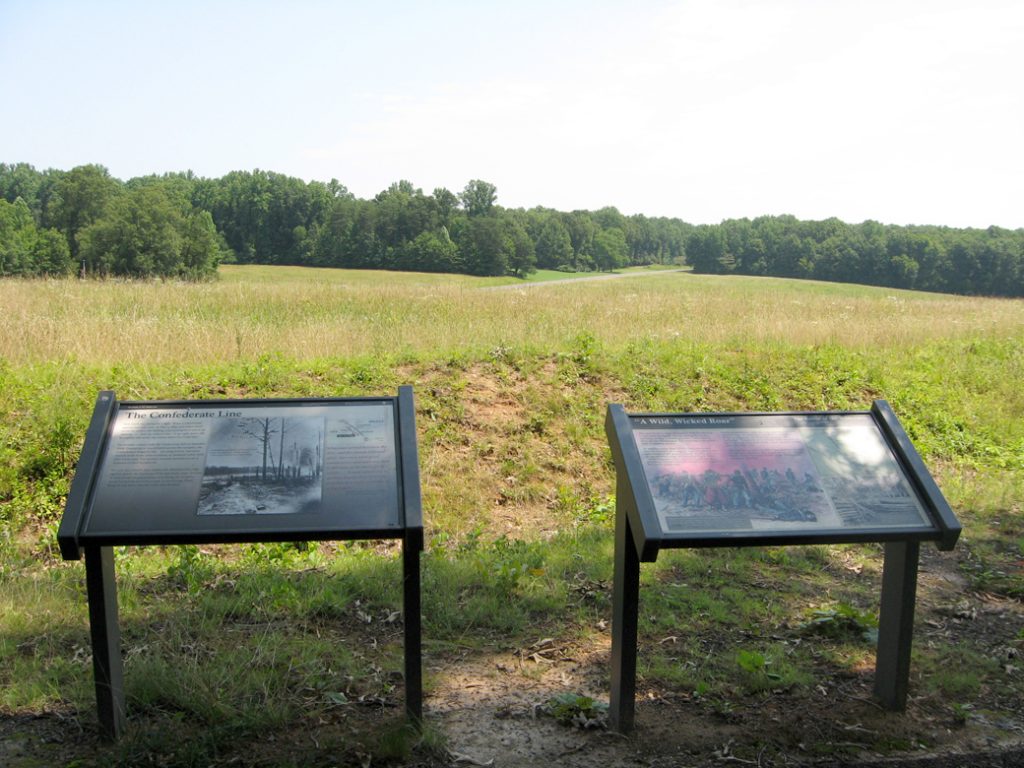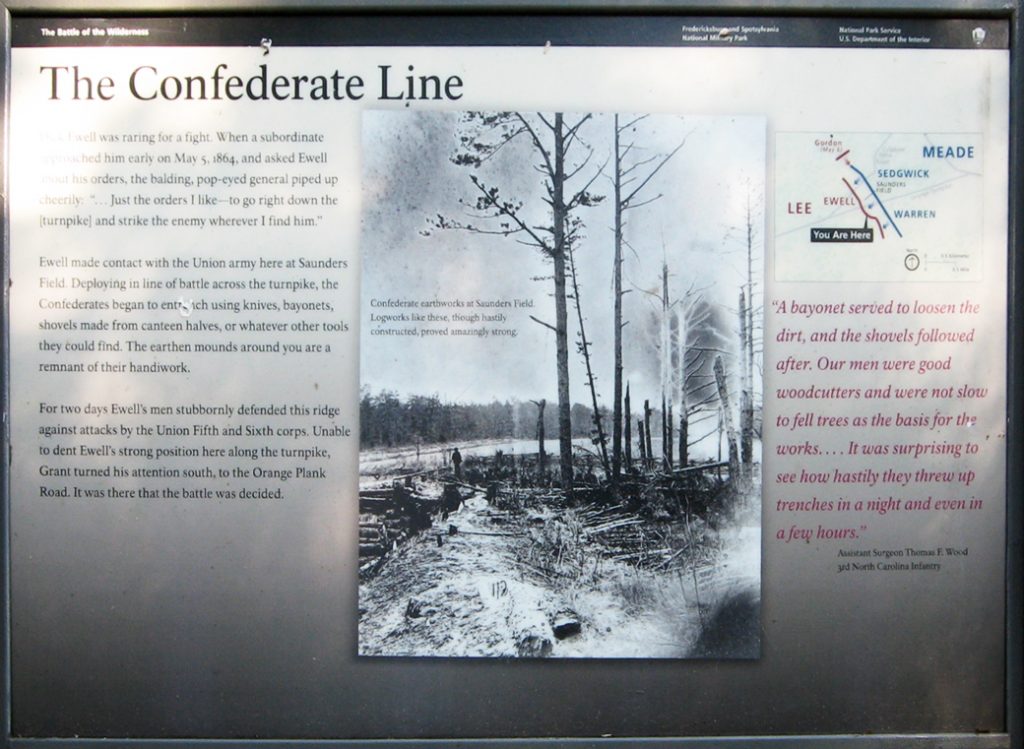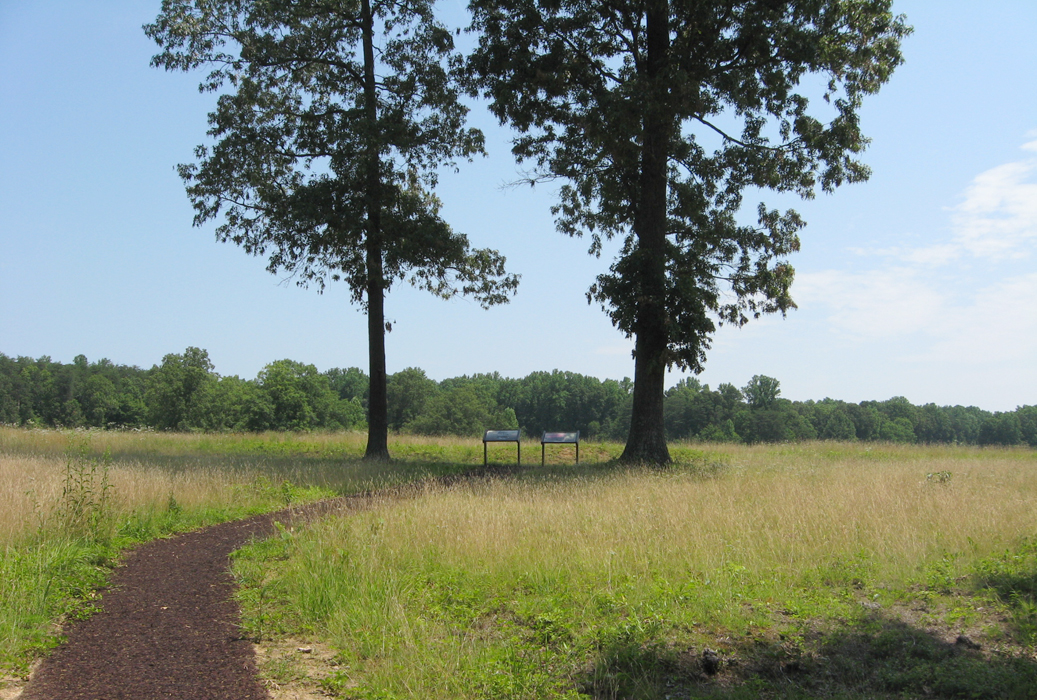Battle of the Wilderness • Tour the Battlefield • Monuments & Markers • The Armies
 “The Confederate Line” and “A Wild, Wicked Roar” waysde markers are at Stop Three of the Wilderness Battlefield Auto Tour.
“The Confederate Line” and “A Wild, Wicked Roar” waysde markers are at Stop Three of the Wilderness Battlefield Auto Tour.

The “Confederate Line” (left) and “A Wild, Wicked Roar” (right) wayside markers at Stop Three on the Wilderness Battlefield
The Confederate Line wayside marker

Text from the marker:
The Confederate Line
Dick Ewell was raring for a fight. When a subordinate approached him early on May 5, 1864, and asked Ewell about his orders, the balding, pop-eyed general piped up cheerily “…Just the orders I like–to go right down the [turnpike] and strike the enemy wherever I find him.”
Ewell made contact with the Union army here at Saunders Field. Deploying in line of battle across the turnpike, the Confederates began to entrench using knives, bayonets, shovels made from canteen halves, or whatever other tools they could find. The earthen mounds around you are a remnant of their handiwork.
For two days Ewell’s men stubbornly defended this ridge against attacks by the Union Fifth and Sixth corps. Unable to dent Ewell’s strong position here along the turnpike, Grant turned his attantion south, to the Orange Plank Road. It was there that the battle was decided.
“A bayonet served to loosen the dirt, and the shovels followed after. Our men were good woodcutters and were not slow to fell trees as the basis for the works….It was surprising to see how hastily they threw up trenches in a night and even in a few hours.”
Assistant surgeon Thomas F. Ward
3rd North Carolina Infantry
Caption to the photo at center:
Confederate earthworks at Saunders Field. Logworks like these, though hastily constructed, proved amazingly strong.
A Wild, Wicked Roar waysde marker

Text from the marker:
A Wild, Wicked Roar
The arrival of Lt. Gen. Richard S. Ewell’s Second Corps here along the Orange Turnpike on the morning of May 5 challenged the Union march through the Wilderness. The Federals responded with a massive attack.
At midday more than 12,000 Federal troops moved forward on a jagged, mile-long front. The spearhead of the assault struck Ewell’s line here, on the western edge of Saunders Field. Three Union brigades rolled over the Confederates, plunging forward through thickets and brambles for nearly a half mile.
Ewell scrambled to rally his men, and soon a “wild, wicked roar” of musketry engulfed the Union lines. Without supports, the Federals stopped, then retreated. Thousands of blue-clad fugitives dashed back through Saunders Field – most of them faster than they had come.
After the attack here on May 5 the heaviest fighting would shift farther to the south, along the Orange Plank Road. There the Battle of the Wilderness would be decided.
Caption to the drawing on the lower left:
Saunders Field burned on the afternoon of May 5.
“The clearing became a raging inferno, in which many of the wounded perished and the bodies of the dead were blackened and burned beyond all possibility of recognition, a tragic conclusion to this day of horror.”
– A man of the 146th New York
Caption to the photo on the lower right:
Ewell’s men took advantage of lulls in the fighting to build these sturdy earthworks, the remains of which are behind you.

The markers are about 120 feet north of the pull off at Stop Three
